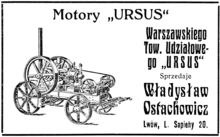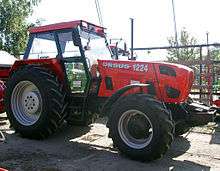Ursus Factory
The Ursus Factory is a Polish producer of agricultural machinery located in Lublin. In the 2010s, it has also carried out some production of trolleybuses in a joint venture with the Ukrainian manufacturer Bogdan.
History
Early history


The Ursus Factory was founded in Poland in 1893 on 15 Sienna Street, Warsaw, by three engineers and four businessmen. It began producing exhaust engines and then later trucks and metal fittings intended for the Russian Tsar.
In 1930, the Ursus factory fell on hard times due to the world financial crisis and was nationalised under the Państwowe Zakłady Inżynieryjne (National Engineering Works, PZInż), the Polish manufacturer of arms and vehicles. It then began producing military tractors, tanks and other heavy machinery for troops. During the German occupation of Poland in World War II the factory was controlled by FAMO and produced Panzer II, Marder II and Wespe AFVs. After the war, the Ursus Factory started producing the Ursus C-45, a copy of the German pre-war Lanz Bulldog tractor. During the 1950s, the Ursus factory began producing tractors using a Zetor-based design.
By 1961, there was a growing need for tractors in Poland, but the tractors produced by the Ursus factory did not meet the needs of Polish agriculture. A bilateral agreement was created between Poland and Czechoslovakia, where Czechoslovakia would provide the Ursus factory with the parts necessary to enlarge and modernise the factory and in exchange, Poland would supply Czechoslovak factories with raw materials. The goal was to construct a joint tractor industry where Poland and Czechoslovakia would combine to produce 120,000 tractors per year, as in 1963 Poland was only producing 15,000.
Solidarity
Workers of the Ursus tractor factory played a large role in the solidarity movement in the 1970s and 1980s. On 25 June 1976 in response to a rise in food prices, the workers of Ursus, acting in solidarity with workers in Radom and many other areas, went on strike and blocked and destroyed parts of the main east-west and north-south rail lines leaving Warsaw. This was one of the largest and most disruptive strikes that occurred that day, and resulted in the prime minister announcing on television the withdrawal of the food price increase.
In 1980, workers of the Ursus factory went on strike and spent the night at the factory to protest the detention of Jan Narozniak, a volunteer printing worker at the Warsaw chapter of Solidarity. Also in 1980, 16,000 workers threatened to stop coming to work on Saturdays in order to self-enforce the 5-day work week proclaimed by the Solidarity movement. In 1988, 200 workers in the Ursus factory occupied the plant canteen and demanded that the management petition for increased wages, the release of imprisoned workers, and the legalisation of Solidarity and the Independent Students' Association.
Investment under Gierek
The Ursus factory was the focus of an extensive investment initiative in the 1970s under Edward Gierek. Under this programme, large loans were taken from western banks for the purpose of importing modern equipment and methods that would cause expansion of Polish industry and growth of the Polish economy. In 1977, a 7.9 million dollar export-import bank loan and a 7 million dollar loan from private American banks were granted to the Ursus tractor factory for the purpose of purchasing machine tools from the Ingersoll Milling Machine Company of Rockford, Illinois, and Gleason Works in Rochester, New York. However, such investment programmes became inefficient and failed, leaving Poland with an immense debt.
By 1980, 25 billion dollars were locked into inefficient, unfinished projects in Polish industry that were speculated to require an additional 50 billion dollars to complete. The Ursus Tractor Factory was one of the largest victims of this problem. By 1981, equipment that had been purchased in the West at the Ursus Factory amounted to 3,600 million złoty. Warehouse space at Ursus was filled with unused, unnecessary supplies, e.g. a stock of 1.6 million rarely used screws, and since construction of new warehouse space had stopped, other supplies were left to deteriorate outside. Gierek had invested nearly 1 billion dollars into a project of developing a modern Massey Ferguson model of tractor at Ursus, however due to licensing problems, these tractors could not be sold in the Western Bloc during the Cold War for political reasons, and in the Eastern Bloc neither because they were too expensive. Instead of the targeted production of 75,000 tractors per year, only 500 were made.
Ursus today

Ursus' tractor production declined throughout the 1990s, falling from 60,000 tractors per year in 1980 to about 16,000 tractors in 1995. The decline in production was due to the enormous debt that Ursus had contracted as a result of its expansion programme in the 1980s. The need to repay the debt blocked access to funds needed for the daily operations of the factory. In 1996, 550 million złoty, 80% of Ursus’ debt, owed to nearly 700 creditors, was written off. Tractor sales continued to decline to an all-time low of 1,578 units in 2006.
URSUS Company was established in the years 1998–2003 as a consequence of restructuring and cooperation of PHZ "Bumar" Ltd., ZPC URSUS SA and Ursus Tractor Factory Ltd. The company is still producing Ursus tractors. Bumar Ltd became the main shareholder of Ursus Company, leading to Ursus becoming part of Bumar Industrial Group, which is marketing Ursus products both on foreign and domestic markets.
In 2007, Uzel Holding of Turkey announced they were buying 51% of Ursus.[1] Both Uzel and Ursus are, or were, licensees of AGCO's Massey Ferguson. In 2008 it was announced that Uzel had not kept up to its commitments, and TAFE and Pol-Mot were interested in buying.[2][3]
In 2011 Pol-Mot bought the Ursus Company from Bumar Ltd.[4] Recently, the company is expanding its business in Central Europe and other countries, as well as planning to produce electric buses.[5]
In 2013, a joint venture between Ursus and the Ukrainian company Bogdan received an order for 38 trolleybuses for the Lublin, Poland, trolleybus system.[6] The body-and-chassis shells were completed by Bogdan and shipped to an Ursus plant in Lublin, where Ursus would install the axles, electrical propulsion equipment (supplied by Cegelec), seats and other fittings, to complete the vehicles.[6] The first of the 38 Urbus/Bogdan trolleybuses, officially designated as model Ursus T70116, was delivered in mid-2013,[7] and the last were delivered in mid-2015.[8]
Ursus signed an agreement worth USD 10 million in 2014 to deliver 3000 tractors to Ethiopia[9][10]
Sources
External links
- Official website (in Polish)
- Website of enthusiasts of Ursus plants (in English) (in Polish)
- Ursus video clip collection
- Photo gallery of the abandoned halls
References
- ↑ Uzel buys 51 percent of Ursus, Turkish Daily News, September 12, 2007.
- ↑ "Tractors and Farm Equipment Limited: Private Company Information - Businessweek". Businessweek.com.
- ↑ "Pol-Mot wants to buy Ursus tractor producer again". pb.pl.
- ↑ http://lubelskie.coie.gov.pl/en/aktualnosci/a,113,ursus-back-in-lublin.html
- ↑ "Ursus. Od traktorów do elektrycznych autobusów". interia.pl. 7 May 2014.
- 1 2 Trolleybus Magazine No. 310 (July–August 2013), p. 106. UK: National Trolleybus Association. ISSN 0266-7452.
- ↑ Trolleybus Magazine No. 312 (November–December 2013), p. 164.
- ↑ Trolleybus Magazine No. 324 (November–December 2015), p. 180.
- ↑ http://www.wbj.pl/article-63894-ursus-sells-3000-tractors-to-ethiopia.html
- ↑ "allAfrica.com: Ethiopia: Polish Billionaire Shows Interest in Ethiopia". allAfrica.com.
| Wikimedia Commons has media related to Ursus vehicles. |